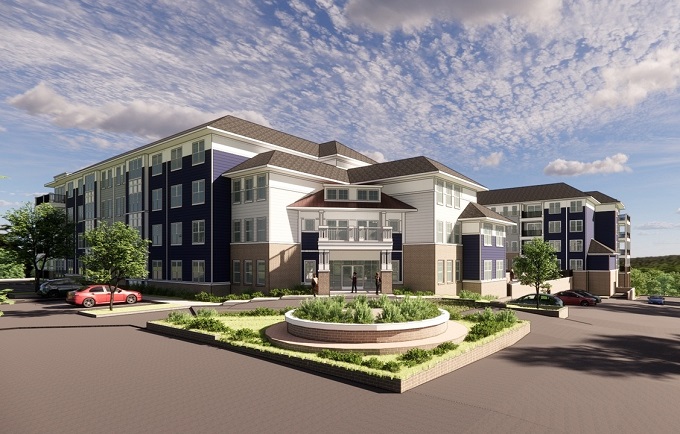
A rendering of the four- and five-story building that would house the age-restricted apartments. (File images courtesy Larry Shaia)
Disagreement over how apartment projects in Hanover have been regulated in the past and should be in the future resulted in a divided Board of Supervisors rejecting a known developer’s latest proposal at its meeting this month.
Supervisors voted 4-3 to deny the proposed Summerlyn development that would have been the county’s first 55-and-up rental community. The denial went against the recommendations of the Planning Commission and county planning staff to approve the project, which the commission supported unanimously last month.
The nay-voters maintained that the 97-unit project was too dense for the site according to the county’s comprehensive plan, which recommends calculating density based on net acreage.
Planning staff and developer Larry Shaia maintained that the county had historically calculated density based on gross acreage, as was the case with Shaia’s Cambridge Square and Charleston Ridge developments.
A recent update to the plan had been drafted with the word “gross” included in it to better reflect the county’s practice, according to Chairman Canova Peterson, whose Mechanicsville District includes the project site. But the word was removed before the new plan was adopted Sept. 27, according to county planning staff and Shaia, who maintained that Summerlyn was proposed based on the previous approvals.
“All this was done before Sept. 27,” Shaia said. “The new comprehensive plan, as we all know, was approved with some changes at the very last minute, something that we could not anticipate.”
Supervisor Michael Herzberg countered that neither the old or new plan included the word “gross” and that, accordingly, the site’s multifamily residential zoning restricts density to no more than 15 units per net acre. With about a third of the 6.5-acre site undevelopable due to protected wetlands, the net-acreage calculation comes out to 81 units, he noted.
“The ordinance requires net density. Whether it’s the 2017 comp plan or the new 2023 comp plan, they both have a recommended maximum of 15 units per acre,” Herzberg said.
“The problem here is the ordinance clearly requires net density, and when that calculation is done, you’re at 18 units per acre,” he told Shaia. “Whether it’s the 2017 comp plan or the 2023 comp plan, they both have a recommended maximum density of 15. As a board member I hope you understand that’s what I have to go by.”
South Anna Supervisor Susan Dibble, the board’s vice chair, agreed.
“This is a great project, there certainly is a huge need, and I recognize that Mr. Shaia builds a great, quality project and maintains those projects. That’s not the problem,” Dibble said.
“The problem is approving this tonight sets a bad precedent and would be in direct conflict with what we have approved, and that would be (that) 15 units maximum is 81 units,” she said. “Anything above 81 is unacceptable, and I will not be able to support this project because of that.”
Proposed at 7147 Mechanicsville Turnpike, an undeveloped parcel beside Cambridge Square, Summerlyn had been reduced in size from an initial proposal that called for 144 units and was rejected by supervisors earlier this year. Initially proposed as a second phase of Cambridge Square, Summerlyn was redrawn as a standalone community with a shared connection to the adjacent 207-unit complex.
The reworked proposal also included a $209,000 cash proffer for road improvements that would be needed for the development.
Shaia proposed the project with Jesse Lennon, a local real estate investor who purchased the site in 2004 for $250,000. Shaia put the project cost at upwards of $27 million and had said a reduction to 81 units would make it unfeasible.
Peterson, the board chairman, maintained that the update to the comprehensive plan should not require Shaia to change his project, since it was proposed before the new plan was approved and with the understanding that it would be based on the gross-acreage calculation.
“I look at this, and I have been in the building and design business for years, and nobody has ever been required to change after they started a project to meet new conditions that were created after the project had begun,” Peterson said.
“I know we can play a lot of games with numbers, but I’m looking at a project that’s a quality project that’s been brought here…and it’s being done by a developer who has a proven track record of building quality projects and maintaining them in a quality manner.”
Eight residents of Cambridge Square spoke in support of the project during a public hearing, while two speakers opposed it, citing the net-density requirement.
Ultimately, Herzberg, Dibble, Sean Davis and Brent Helmick voted the proposal down, outnumbering Peterson, Robert Monolo and Faye Prichard.
Before the vote, Prichard, who represents the Ashland District, noted the Planning Commission’s unanimous support and described the project as needed in Hanover and the right fit for the site.
“These are affordable ways for people to live in a quality product, and I don’t know how we could do better than this,” she said. “This is the right thing in the right place, and our Planning Commission said yes, seven to nothing.”
Asked last week if he and Lennon would contest the board’s vote or pursue the project further, Shaia said they had not made a decision.

A rendering of the four- and five-story building that would house the age-restricted apartments. (File images courtesy Larry Shaia)
Disagreement over how apartment projects in Hanover have been regulated in the past and should be in the future resulted in a divided Board of Supervisors rejecting a known developer’s latest proposal at its meeting this month.
Supervisors voted 4-3 to deny the proposed Summerlyn development that would have been the county’s first 55-and-up rental community. The denial went against the recommendations of the Planning Commission and county planning staff to approve the project, which the commission supported unanimously last month.
The nay-voters maintained that the 97-unit project was too dense for the site according to the county’s comprehensive plan, which recommends calculating density based on net acreage.
Planning staff and developer Larry Shaia maintained that the county had historically calculated density based on gross acreage, as was the case with Shaia’s Cambridge Square and Charleston Ridge developments.
A recent update to the plan had been drafted with the word “gross” included in it to better reflect the county’s practice, according to Chairman Canova Peterson, whose Mechanicsville District includes the project site. But the word was removed before the new plan was adopted Sept. 27, according to county planning staff and Shaia, who maintained that Summerlyn was proposed based on the previous approvals.
“All this was done before Sept. 27,” Shaia said. “The new comprehensive plan, as we all know, was approved with some changes at the very last minute, something that we could not anticipate.”
Supervisor Michael Herzberg countered that neither the old or new plan included the word “gross” and that, accordingly, the site’s multifamily residential zoning restricts density to no more than 15 units per net acre. With about a third of the 6.5-acre site undevelopable due to protected wetlands, the net-acreage calculation comes out to 81 units, he noted.
“The ordinance requires net density. Whether it’s the 2017 comp plan or the new 2023 comp plan, they both have a recommended maximum of 15 units per acre,” Herzberg said.
“The problem here is the ordinance clearly requires net density, and when that calculation is done, you’re at 18 units per acre,” he told Shaia. “Whether it’s the 2017 comp plan or the 2023 comp plan, they both have a recommended maximum density of 15. As a board member I hope you understand that’s what I have to go by.”
South Anna Supervisor Susan Dibble, the board’s vice chair, agreed.
“This is a great project, there certainly is a huge need, and I recognize that Mr. Shaia builds a great, quality project and maintains those projects. That’s not the problem,” Dibble said.
“The problem is approving this tonight sets a bad precedent and would be in direct conflict with what we have approved, and that would be (that) 15 units maximum is 81 units,” she said. “Anything above 81 is unacceptable, and I will not be able to support this project because of that.”
Proposed at 7147 Mechanicsville Turnpike, an undeveloped parcel beside Cambridge Square, Summerlyn had been reduced in size from an initial proposal that called for 144 units and was rejected by supervisors earlier this year. Initially proposed as a second phase of Cambridge Square, Summerlyn was redrawn as a standalone community with a shared connection to the adjacent 207-unit complex.
The reworked proposal also included a $209,000 cash proffer for road improvements that would be needed for the development.
Shaia proposed the project with Jesse Lennon, a local real estate investor who purchased the site in 2004 for $250,000. Shaia put the project cost at upwards of $27 million and had said a reduction to 81 units would make it unfeasible.
Peterson, the board chairman, maintained that the update to the comprehensive plan should not require Shaia to change his project, since it was proposed before the new plan was approved and with the understanding that it would be based on the gross-acreage calculation.
“I look at this, and I have been in the building and design business for years, and nobody has ever been required to change after they started a project to meet new conditions that were created after the project had begun,” Peterson said.
“I know we can play a lot of games with numbers, but I’m looking at a project that’s a quality project that’s been brought here…and it’s being done by a developer who has a proven track record of building quality projects and maintaining them in a quality manner.”
Eight residents of Cambridge Square spoke in support of the project during a public hearing, while two speakers opposed it, citing the net-density requirement.
Ultimately, Herzberg, Dibble, Sean Davis and Brent Helmick voted the proposal down, outnumbering Peterson, Robert Monolo and Faye Prichard.
Before the vote, Prichard, who represents the Ashland District, noted the Planning Commission’s unanimous support and described the project as needed in Hanover and the right fit for the site.
“These are affordable ways for people to live in a quality product, and I don’t know how we could do better than this,” she said. “This is the right thing in the right place, and our Planning Commission said yes, seven to nothing.”
Asked last week if he and Lennon would contest the board’s vote or pursue the project further, Shaia said they had not made a decision.

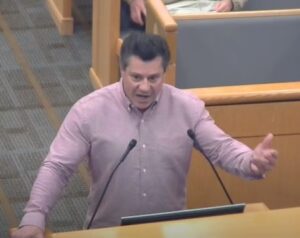
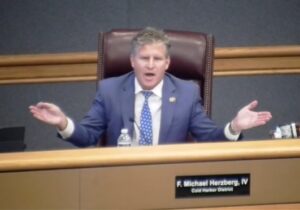
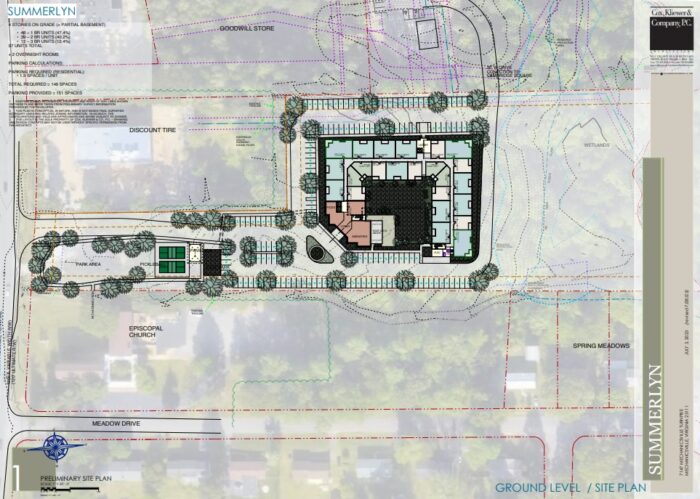
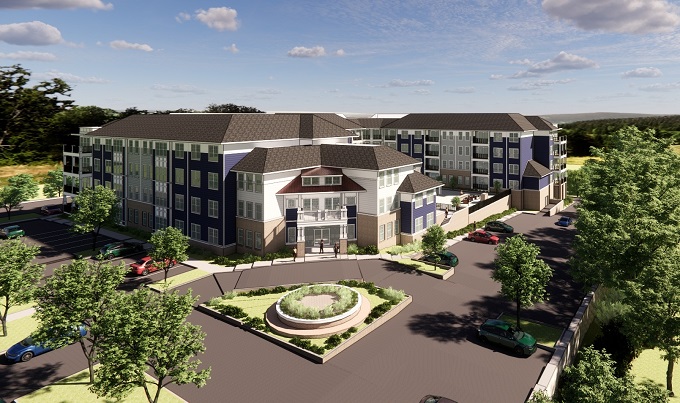


Sometimes government needs to get out of its own way and reach a little bit when a development proposal fits the needs of the community and the land for which it’s proposed. This is such a proposal. Besides that, it was proposed by the standards that were in place when it was designed. Larry is right about this and he’s agreed to set aside and protect wetlands as well. The Supervisors have erred.
Yes, we definitely need to develop every square inch of 360 and multiply the current traffic morass.
This was a perfect infill project. Traffic on 360 is not nearly as bad since they redid the 295/Bell Creek stretch and this area of 360 is currently under construction to widen it. Also being 55 plus housing, how many extra car trips are being added to the roads? Not many I would surmise. The Pole Green project that was approved the other week by the board is going to cause a lot more traffic issues than this.
“not nearly as bad.” It is significantly worse than it was even a year or two ago.
WTH bro?
Agreed on all points, Bruce. Larry Shaia is well known for quality developments, and this project is certainly needed. Seems like the BOS have moved the goalposts – and they did so AFTER the project was well in the works. That the county Planning Commission voted unanimously to support this development speaks volumes. So the BOS is willing to scuttle the entire project for a grand whopping total of 16 units? Looks like a classic example of “cutting off one’s nose to spite one’s face.”
This is a bad look for Hanover’s Board of Supervisors given the plot of land isn’t suitable for much else and it would be a quality development. The aging population of Hanover would love to stay in the area while downsizing to a community like this proposal. Big picture the Richmond region (and the country overall) lacks necessary single floor living options as boomers become less mobile.
100% agreed, Justin. I qualify as being in that 55+ category. There’s a dearth of 55+ housing all over the country – and it’s particularly notable in parts of metro RVA, such as Hanover. Projects like this one by Larry Shaia are at least a step to alleviating the shortage. I’m saddened to see this one hit such an unnecessary roadblock.
55 plus development is a net positive tax revenue producer unlike traditional real estate development. No impact on schools, less transportation impact, non existent crime etc Virginia has done a lackluster job at tapping into this goldmine with its four seasons, Coastal to Mountain landscape, reasonable cost of living etc this driving thousands to the Carolina’s and Florida. This segment also has more spendable dollars benefiting businesses. I guess they can approve a traditional housing situation and financially shoot themselves in the foot